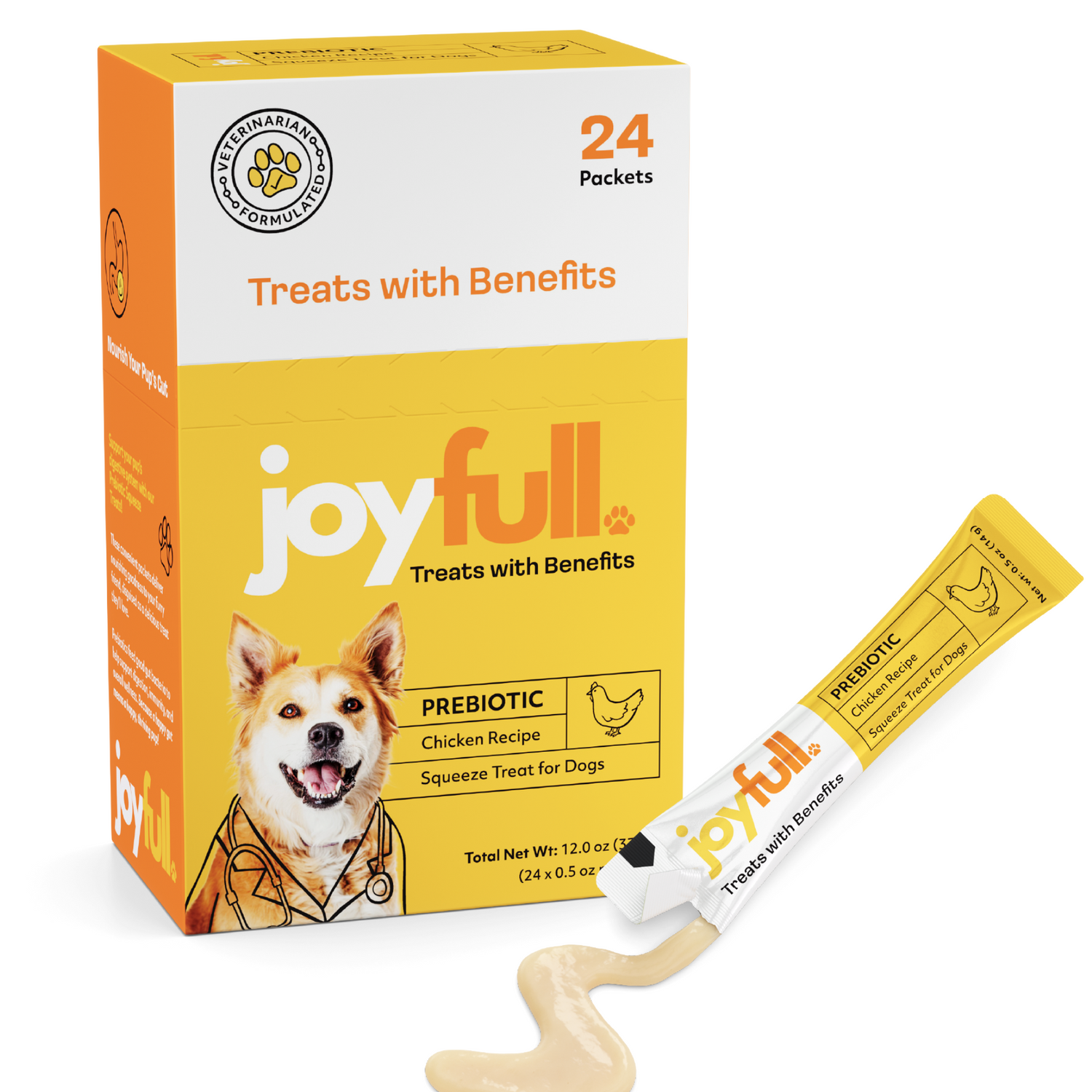
Cat Treats for Urinary Health A Pet Owner's Guide
When you hear about "cat treats for urinary health," you might wonder what makes them so special. Think of them less as a simple snack and more as a functional supplement designed to support your cat's entire urinary system. These treats are packed with ingredients that encourage your cat to drink more water, help keep their urine pH in a healthy range, and lower the risk of painful crystal formation. They're a fantastic, proactive way to support a balanced diet and your cat's long-term wellness, especially if your kitty is already prone to urinary troubles.
Decoding Feline Urinary Health
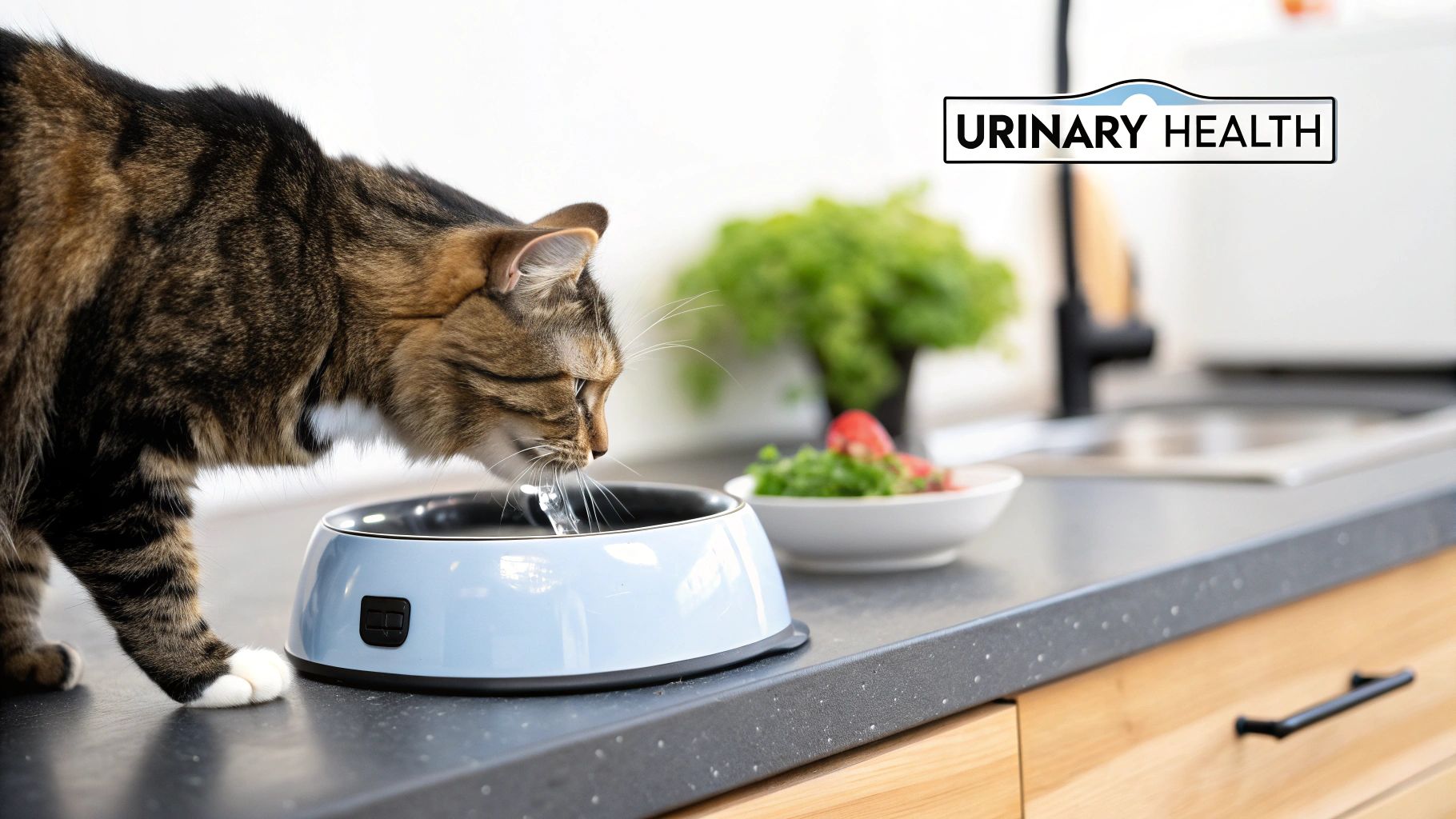
To really get why these treats are so important, picture your cat’s urinary system as a highly sophisticated plumbing network. Its main job is to filter out waste from the blood and flush it out of the body. When everything is flowing smoothly, your cat is happy and healthy.
But just like pipes can get clogged with mineral buildup, a cat's urinary tract can be thrown off balance. Tiny, microscopic crystals can start to form, and this is where the concept of urine concentration becomes a big deal.
Our house cats descended from desert animals, and they inherited an amazing ability to conserve water by producing very concentrated urine. While that's a brilliant survival skill in the wild, it can backfire for a modern indoor cat who might not be drinking enough. Super-concentrated urine is the perfect breeding ground for minerals like struvite and calcium oxalate to solidify into crystals.
The Balancing Act of pH and Hydration
A huge factor in preventing this is urine pH. Imagine a scale from acidic to alkaline. If a cat's urine becomes too alkaline, it's the perfect environment for struvite crystals to form. On the flip side, overly acidic urine can lead to calcium oxalate crystals. The sweet spot is a slightly acidic balance that keeps those minerals dissolved and moving right on out.
This is exactly why hydration is the absolute foundation of good urinary health. The more water your cat drinks, the more diluted their urine becomes. This helps in two critical ways:
- It physically flushes out the mineral "sand" before it has a chance to clump together into "rocks."
- It helps maintain that ideal pH balance, making it much harder for crystals to ever get started.
You'll often hear vets talk about Feline Lower Urinary Tract Disease, or FLUTD. This isn't one specific illness but rather a catch-all term for a range of issues affecting the bladder and urethra, from inflammation and infections to life-threatening blockages.
Why Cats Are So Prone to Urinary Problems
It often feels like cats are uniquely susceptible to these issues, and in many ways, they are. Their naturally low thirst drive, sometimes combined with a diet of dry food that has a high mineral content, can create a perfect storm. Stress is another massive trigger, often leading to a painful condition called Feline Idiopathic Cystitis (FIC), where the bladder gets inflamed for no clear reason.
As both pet parents and veterinarians have become more aware of these risks, the demand for proactive solutions has skyrocketed. People are no longer waiting for a problem to appear; they're actively looking for foods and treats that can help prevent issues like UTIs and FLUTD from ever starting. You can see this shift reflected in the growing market for specialized pet products, often detailed in industry analyses.
The First Line of Defense: A proactive approach combining a balanced diet, ample hydration, and stress reduction is the most effective way to protect your cat's urinary system. Specialized cat treats for urinary health serve as a valuable part of this strategy, supporting this delicate internal ecosystem.
Once you understand the why behind your cat’s urinary needs, it’s much easier to see the vital role that diet, hydration, and the right kinds of treats play in keeping them healthy for years to come.
The Building Blocks of a Healthy Urinary Tract
When you flip over a bag of cat treats promising urinary health support, that long list of ingredients can feel a little overwhelming. But learning to read the label is the single most powerful thing you can do for your cat. Think of it as looking under the hood—you want to see what’s really powering the formula.
The best urinary support treats aren’t just a random mix of ingredients. They are carefully formulated, with each component chosen for a specific job. Together, they create a team that works to keep your cat’s urinary system balanced, hydrated, and resilient.
Powerhouse Ingredients to Look For
Certain ingredients are absolute all-stars in the world of urinary health. They don't just react to problems; they work proactively to maintain a healthy bladder and flush out troublemakers before they can cause issues. When you spot these on a label, you know you're on the right track.
Cranberry is probably the most famous one, and for good reason. It’s packed with compounds called proanthocyanidins (PACs). The best way to think about PACs is that they make the bladder wall slippery, like a non-stick pan. This helps prevent nasty bacteria (like E. coli) from getting a grip, so they are simply flushed out with the urine.
Another key player is D-Mannose. This is a simple sugar that acts like a decoy. It latches onto harmful bacteria, neutralizing their ability to stick to the urinary tract lining. It's a fantastic ingredient for keeping the bladder environment clean and healthy.
Finally, there’s glucosamine. This is a vital building block for the bladder’s protective inner lining, known as the GAG (glycosaminoglycan) layer. A thick, healthy GAG layer acts like a shield, preventing urine and its byproducts from irritating the delicate tissue underneath.
This chart shows just how different a specialized urinary treat is from a standard one.
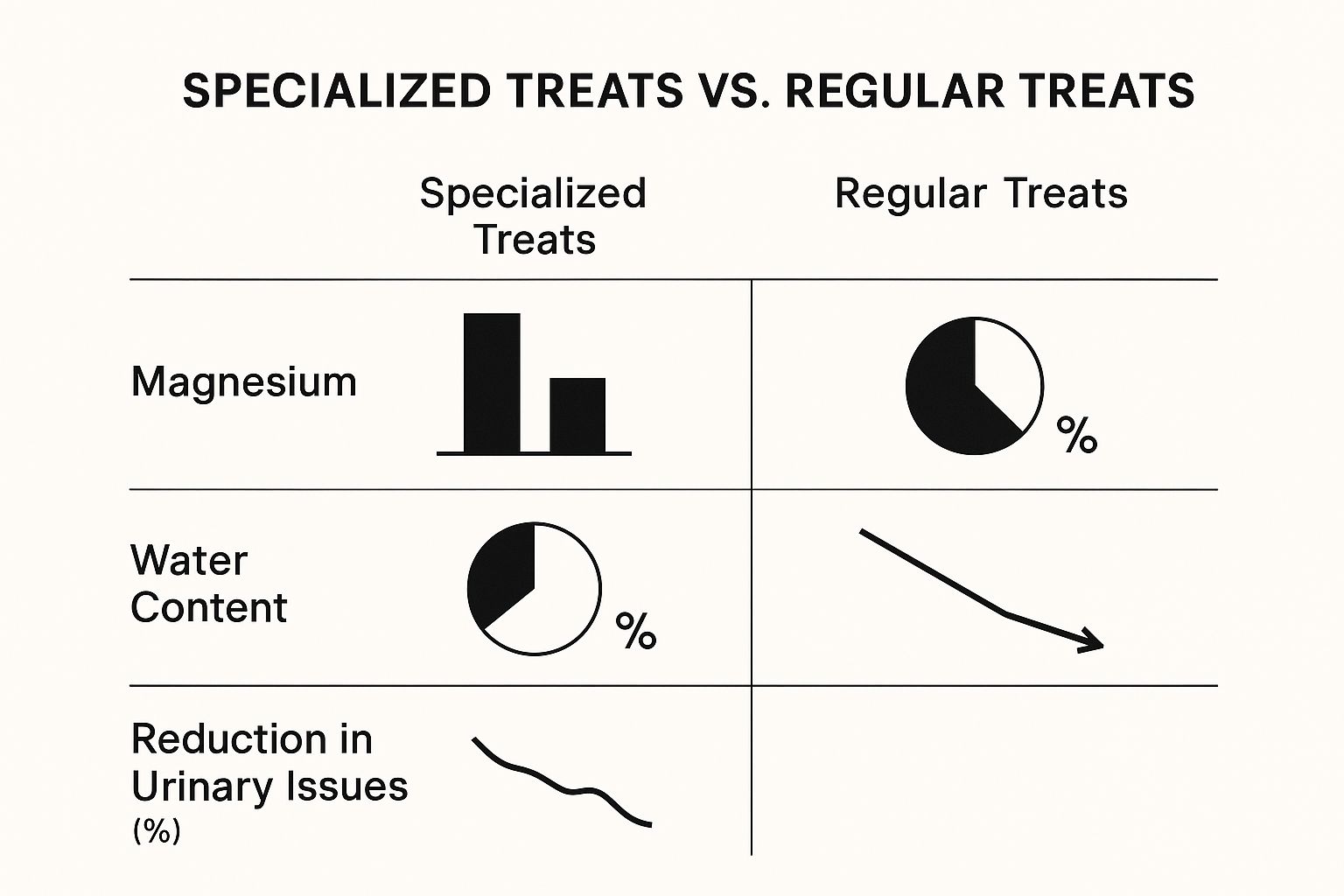
As you can see, the formulation is intentionally designed with lower mineral content and higher moisture to actively support urinary function.
The Role of Healthy Fats and Quality Protein
Beyond the specialized supplements, the very foundation of the treat matters. Omega-3 fatty acids, usually from a source like fish oil, are fantastic for taming inflammation throughout the body—and that includes the urinary tract. This can help soothe irritation and keep your cat comfortable.
High-quality animal protein is non-negotiable. It does more than just make the treats irresistible to your little carnivore; it also helps maintain a slightly acidic urine pH. Keeping that pH in the right zone is a crucial strategy for preventing the formation of common struvite crystals. You can learn more in our guide to the benefits of high-protein cat treats.
A Team Effort: The most effective urinary health treats don't just lean on one hero ingredient. They create synergy by combining multiple helpers—like cranberry for its anti-stick properties, glucosamine to reinforce the bladder wall, and omega-3s to cool inflammation. This multi-pronged approach offers the best defense for your cat's urinary system.
Ingredients to Avoid or Limit
Knowing what not to look for is just as important. Some ingredients can undermine all your efforts, contributing to the very issues you're trying to solve.
Navigating the ingredient list is much easier when you know which ingredients are friends and which are foes. This table breaks it down simply.
Beneficial vs. Problematic Ingredients in Urinary Cat Treats
| Ingredient Category | Beneficial Examples & Their Function | Problematic Examples & Their Risks |
|---|---|---|
| Active Support |
Cranberry, D-Mannose: Prevent bacteria from sticking to the bladder wall. Glucosamine: Strengthens the bladder's protective lining. |
Excessive Plant-Based Protein: Can alter urine pH unfavorably. Artificial Preservatives (BHA, BHT): Add unnecessary chemical load. |
| Protein Source | High-Quality Animal Protein (e.g., chicken, fish): Supports a naturally acidic urine pH and is highly digestible. |
Vague "Meat By-Products": Low-quality, less digestible protein sources. Soy or Corn Gluten Meal: Can be inflammatory fillers. |
| Fats | Omega-3 Fatty Acids (from fish oil, flaxseed): Reduce inflammation in the urinary tract. | Unnamed "Animal Fat": A low-quality, generic fat source with no anti-inflammatory benefits. |
| Minerals | Controlled, Low Levels of magnesium and phosphorus. | Excess Magnesium & Phosphorus: The main building blocks of struvite crystals. High levels are a major risk factor. |
| Fillers & Additives | Moisture-Rich Ingredients (like broth) to aid hydration. |
Corn, Wheat, Soy: Common allergens and fillers that offer little nutritional value. Artificial Colors & Flavors: Unnecessary chemicals. |
| Sodium | Low Sodium Formulas: Support proper hydration and kidney function. | High Sodium: Can lead to dehydration and strain on the urinary system. |
The biggest red flags to watch for are excessive minerals.
Magnesium and Phosphorus are the primary components of struvite crystals. While cats need these minerals, too much of a good thing is a bad thing here. An oversupply can cause the urine to become saturated, creating the perfect storm for crystals to form. Any reputable urinary treat will have carefully controlled levels.
You should also be wary of:
- Excessive Fillers: Ingredients like corn, wheat, and soy add bulk but little nutritional value. For some cats, they can even contribute to inflammation.
- Artificial Additives: There's no good reason for artificial colors, flavors, or chemical preservatives like BHA and BHT in your cat’s treats. They add zero health benefits.
- High Sodium Content: Too much salt can work against your hydration goals and may put extra stress on the urinary system. Always look for low-sodium formulas.
By learning to spot these key ingredients—both the good and the bad—you can choose treats that genuinely support your cat’s health from the inside out.
How to Choose the Right Urinary Health Treats
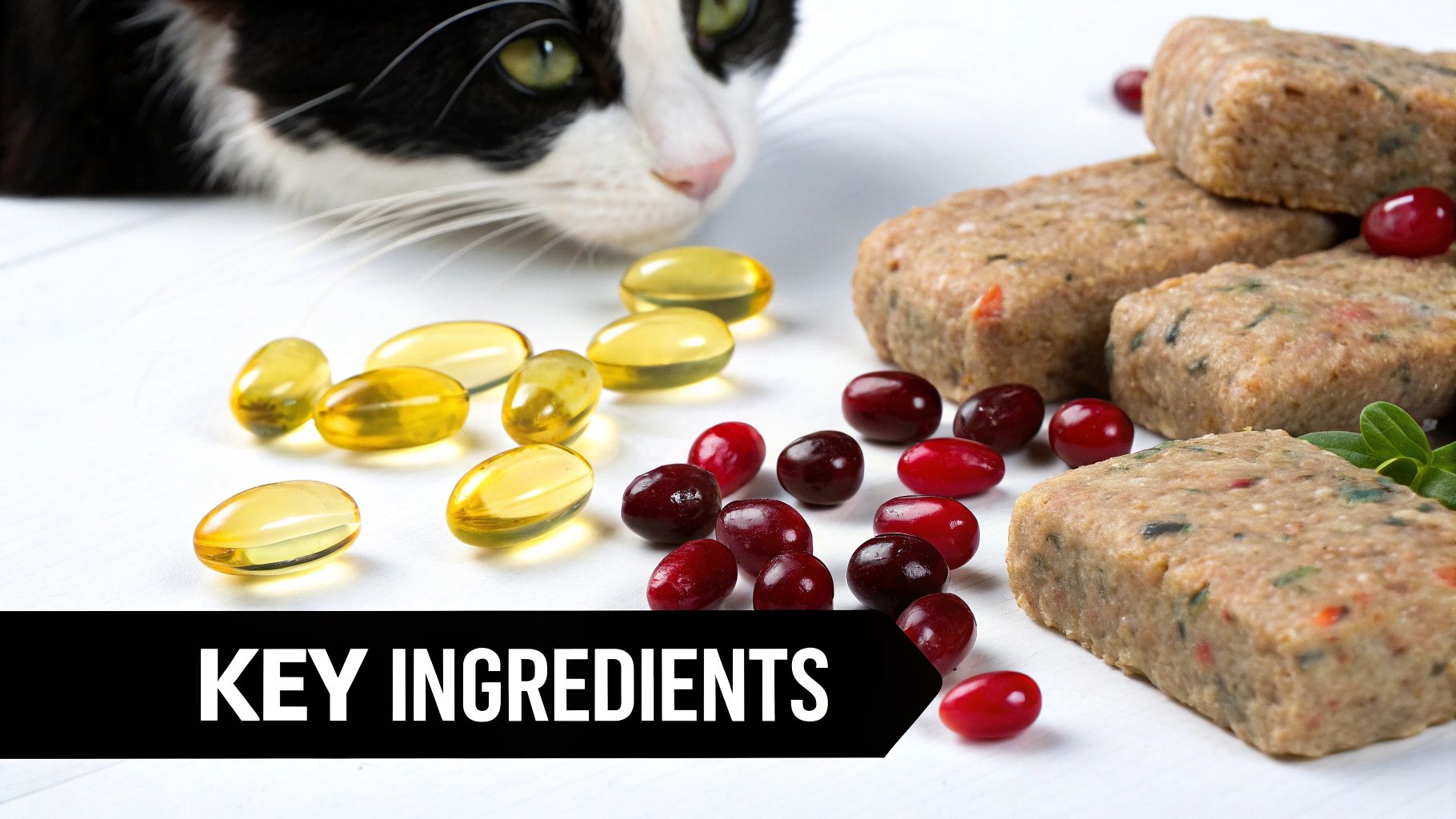
Walking down the pet food aisle can feel pretty overwhelming. You're hit with a wall of colorful bags, all making big promises. But when you know what to look for, you can cut through the noise and confidently pick the best cat treats for urinary health. It’s not about guessing; it's about knowing how to read a label like a pro.
Before you do anything else, loop in your veterinarian. They’re your most valuable partner here. A quick chat before changing your cat's diet can give you personalized advice based on your cat’s unique health history and needs. Think of your vet as your trusted guide for this journey.
Decoding the Packaging Claims
Once you start comparing bags, you'll see a lot of the same phrases pop up. Knowing what they actually mean is your first step to becoming a smart shopper.
- "pH Balancing": This means the treat is designed to keep your cat's urine slightly acidic, which is the sweet spot for preventing certain types of crystals from forming. High-quality animal protein is often the key ingredient that helps achieve this naturally.
- "Low Ash": "Ash" sounds weird, but it's just the mineral content left over if you were to burn the food—think magnesium and phosphorus. A "low ash" label is a good sign, as it means the treat has less of the raw materials that can build up into painful urinary stones.
- "Supports Hydration": This claim usually means the treat has a higher moisture content or contains ingredients that encourage your cat to drink more water. Since getting enough water is the absolute cornerstone of a healthy urinary tract, this is a huge plus.
These phrases are great clues, but the real story is always in the fine print: the ingredient list and the guaranteed analysis.
Analyze the Guaranteed Analysis
That small box of nutritional info on the back of the package? That’s the guaranteed analysis, and it’s packed with vital information. It might look a little technical, but it holds the secrets to a treat's quality.
Your Mission: Zero in on the mineral content. Look for the percentages of magnesium and phosphorus. For a urinary support treat, you want to see these numbers on the lower side.
While you're there, take a look at the crude protein level. A higher percentage is usually a good thing, as long as it comes from a quality animal source. Compare that to the moisture content—a higher number here is always a win, as it sneaks a little extra water into your cat's day.
Prioritize Brand Transparency and Clean Ingredients
Beyond the numbers, think about the company behind the treat. Does the brand feel transparent? A company that truly cares about your pet’s health will be open about where its ingredients come from and how its products are made. Look for brands that stick to simple, clean ingredient lists with words you can actually pronounce.
At Joyfull, we believe what’s left out of our treats is just as important as what goes in. Our recipes are built around high-quality proteins, and we skip the unnecessary fillers and artificial junk that can contribute to health issues down the line. Choosing a brand with this mindset means you’re not just managing one problem—you're supporting your cat's total well-being.
This proactive approach is becoming more popular as cat parents focus on preventing problems before they start. The market shows it, too. The global urinary tract prescription cat food market was valued at around USD 1.8 billion in the early 2020s and is expected to keep growing. This trend makes it clear that more and more people are turning to diet to manage and prevent urinary conditions.
In the end, finding the right treat is a mix of getting good advice from your vet, reading labels carefully, and picking a brand you trust. For more tips on what to look for, check out our guide on https://joyfullpet.com/blogs/news/what-are-good-cat-treats. Making an informed choice is one of the best things you can do for your cat's long-term health and happiness.
How to Weave Urinary Treats Into Your Cat's Diet
So, you've picked out the perfect cat treats for urinary health. That's a huge win! But how you give them to your cat is just as important as which ones you choose. This isn't just about handing over a snack; it's about making these treats a functional part of your cat's wellness plan. A smart strategy ensures they get all the good stuff without messing up their main meals.
The absolute golden rule for any cat treat is the 10% rule. It's simple but non-negotiable: treats should make up no more than 10% of your cat's total daily calories. Your cat’s primary food is carefully balanced to give them everything they need, and too many treats can easily throw that off, leading to weight gain or nutritional imbalances.
How Many Treats Are Too Many?
Figuring out that 10% isn't as complicated as it sounds. First, you need to know how many calories your cat should be eating each day. The feeding guide on their regular food bag is the best place to start.
It's a quick, three-step process:
- Step 1: Find their daily calorie target. A typical 10-pound indoor cat usually needs around 200-250 calories a day.
- Step 2: Calculate your 10% treat budget. For a cat eating 250 calories, 10% is 25 calories. That's your daily allowance for treats.
- Step 3: Check the treat's calorie count. The package will list calories, usually as "kcal/treat." If a treat is 2 calories, you can give your cat about 12 treats spread throughout the day.
Doing this quick math lets you give a consistent, helpful amount of those urinary-supporting ingredients without going overboard.
Consistency is Everything
When you're using treats for a specific health benefit, consistency beats quantity every single time. A big handful of treats once a week just won't cut it. The active ingredients work best when they are always present in your cat’s system, helping to maintain a healthy urinary environment day in and day out.
Think of it like this: A steady, daily routine allows the supportive ingredients to build up and maintain a protective effect in the urinary tract. You're creating a long-term, stable defense, not just a short-term flood of nutrients.
This approach turns a simple treat into a reliable part of their daily health regimen.
Get Creative and Boost Hydration
Treat time is also a golden opportunity to sneak more water into your cat's day. Since proper hydration is the foundation of good urinary health, making drinking more appealing is a massive win.
Here are a few tricks I've seen work wonders:
- Go Fishing: Drop a few moist urinary treats into your cat's water fountain. Many cats love to "fish" them out, and they'll swallow more water in the process.
- Make it a Game: Put the treats in a puzzle feeder. The "hunt" provides great mental stimulation, and cats often head for the water bowl right after a satisfying challenge.
- Frozen Surprises: Pop a couple of small treats into an ice cube tray, fill with water, and freeze. As your cat licks the ice to get to the prize, they’re hydrating without even thinking about it.
By working treats into your cat's routine this way, you're doing more than just giving a snack. You're turning a simple moment into a powerful tool for their health and happiness.
Why Clean Ingredients Matter for Feline Wellness
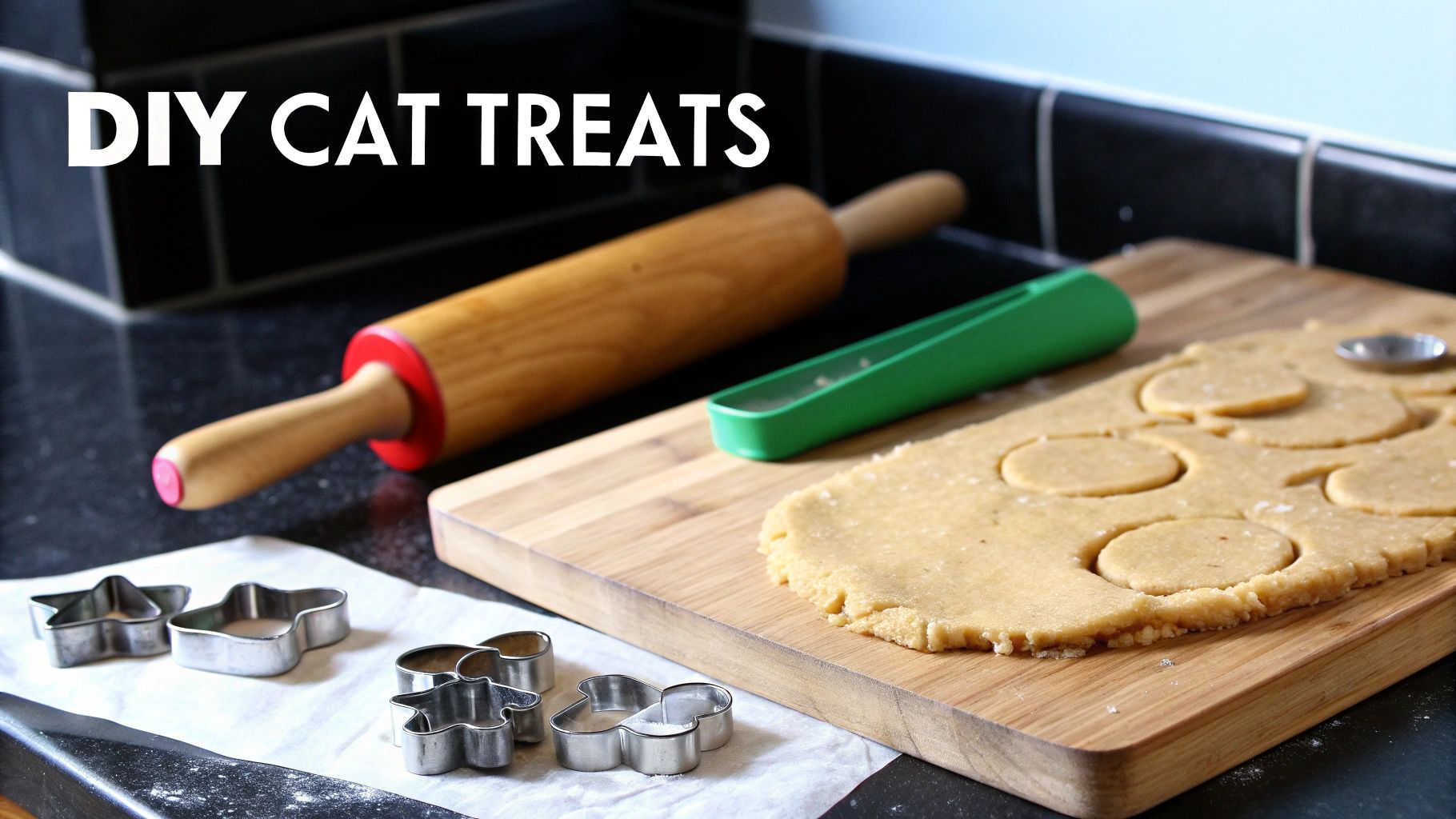
When we're trying to support a cat’s urinary health, it's easy to get tunnel vision and focus only on a few key "active" ingredients. But the truth is, a cat’s overall wellness is built on the foundation of everything they eat—and that absolutely includes their treats. This is where "clean ingredients" come into play, and why they're so non-negotiable for a healthy cat.
Think of your cat’s body like a high-performance engine. To run smoothly, it needs pure, high-octane fuel. Clean ingredients are exactly that. We’re talking about recognizable, whole-food sources that provide real nutritional value, like actual meat, beneficial supplements, and natural preservatives. It’s all the good stuff, without the gunk that can clog up the system.
A clean ingredient list is just as much about what it lacks as what it contains. It’s free from cheap fillers, artificial colors, and synthetic flavors that do absolutely nothing for your cat's health.
How Additives Affect Your Cat’s System
So, what’s the big deal with a few additives? Those artificial ingredients and low-quality fillers do more than just add empty calories. They place a real, physical burden on your cat’s organs, forcing their liver and kidneys to work overtime to filter out substances that shouldn't be there in the first place.
This extra work can contribute to a state of low-grade, systemic inflammation. Imagine a constant, low-level hum of irritation running in the background of your cat’s body. This kind of inflammation can impact every single system, including their very sensitive urinary tract. For a cat that might already be prone to urinary issues, this added stress is the last thing they need.
By choosing treats with a clean, simple formula, you're essentially helping to turn down that inflammatory "noise." When their body isn't wasting energy processing junk, it can dedicate its resources to maintaining true health and balance, taking a huge load off critical systems like the bladder and kidneys.
Taking a Holistic View of Feline Health
This shift toward clean, purposeful nutrition isn't just a fad; it’s a fundamental change in how we care for our pets. We see our cats as family, so naturally, we want to feed them like family. This "humanization" of pet wellness has created a much-needed demand for premium, health-focused products.
Today's pet parents are savvy. They're flipping over the bag, scrutinizing labels, and investing in higher-quality options. It’s a trend that has fueled the growth of specialized markets like cat treats for urinary health. In fact, it’s a bigger market than you might think, as shown by insights on the expanding UTI cat food market.
A purposeful ingredient list doesn’t just manage one health concern—it supports total wellness from the inside out. By avoiding unnecessary additives, you help create a healthier internal environment for your cat.
Opting for clean-ingredient treats is a proactive choice. It’s an acknowledgment that urinary health isn't an isolated issue; it's deeply connected to your cat's overall well-being. By providing simple, high-quality nutrition, you're supporting their entire body and helping them thrive. If you're curious about what to look out for, our guide on common cat food ingredients to steer clear of is a great place to start. This approach ensures every single bite contributes positively to their long-term health.
Your Questions About Urinary Cat Treats, Answered
When it comes to something as vital as your cat's urinary health, it's natural to have questions. You want to feel confident you're doing the right thing. Let's walk through some of the most common concerns we hear from cat parents just like you.
Think of this as a practical guide for real-life situations. We'll give you direct, vet-informed answers to help you make the best choices for your furry family member.
Can Urinary Treats Replace a Prescription Diet?
This is a critical question, and the answer is a hard no. It’s essential to understand that these two things serve completely different purposes.
Cat treats for urinary health are a proactive, supportive supplement. Think of them like a daily vitamin you might take to stay well. They're a fantastic tool for maintaining urinary health in a cat who is generally healthy or has a history of minor issues.
A prescription urinary diet, on the other hand, is medicine in the form of food. These diets are carefully formulated by veterinary nutritionists to actively manage a diagnosed medical problem, like dissolving painful struvite crystals or preventing the recurrence of calcium oxalate stones. They contain precise, therapeutic levels of minerals and pH-balancing agents that a simple treat just can't match.
Your veterinarian prescribed a specific diet for a medical reason. Always follow their advice and use treats only to support their plan, never to replace it.
How Quickly Will I See Results from These Treats?
It's important to set the right expectations here, because these treats are all about playing the long game. This isn't a quick fix for an active problem; it's a long-term strategy for prevention.
You aren't going to see a big, dramatic change overnight. The goal is to consistently support a healthy urinary environment over weeks, months, and even years. This ongoing support is what helps reduce the risk of problems cropping up down the road.
For a healthy cat, the "result" is simply the continued absence of urinary issues. For a cat prone to flare-ups, you might notice they're staying better hydrated and using the litter box more consistently over time. Patience is key.
Are There Any Side Effects to Consider?
When you follow the feeding guidelines, high-quality urinary treats are very safe for most cats. The biggest risk doesn't come from the ingredients themselves, but from giving too many.
Overfeeding is the main thing to watch out for. This can create a couple of problems:
- Weight Gain: All those extra calories can easily lead to obesity, which is a major risk factor for urinary tract issues and other health conditions.
- Dietary Imbalance: This is where the "10% rule" comes in. Treats should never make up more than 10% of your cat's total daily calories. Any more than that, and you risk throwing off the carefully balanced nutrition of their main food.
Like with any new food, it’s a good idea to introduce urinary treats slowly over a few days. This lets your cat's digestive system get used to them and helps you spot any rare, mild stomach upset. Sticking to the recommended serving size is the best way to give them all the benefits with none of the downsides.
How Can I Get My Picky Cat to Eat These Treats?
Winning over a finicky eater takes a little bit of cat psychology. Cats are often suspicious of new things, so making the introduction a positive experience is everything.
Start by choosing treats that are built on a foundation of high-quality animal protein, like real chicken or fish. Cats are carnivores, and these flavors are far more enticing than treats packed with plant-based fillers. Texture is a big deal, too—some cats love a good crunch, while others will only go for soft, chewy morsels.
Here are a few tricks you can try:
- The Hand-Off: Offering a single treat by hand can make it feel like a special, high-value reward.
- The Topper Trick: Crumble a treat over their regular wet or dry food. This introduces the new smell and taste in a familiar, non-threatening way.
- The Post-Play Prize: Use the treat as a reward right after a fun play session with their favorite feather wand. This helps them build a strong positive association with it.
It might take a few tries with different brands or flavors to discover your cat's absolute favorite. Don't get discouraged if the first one is a flop; finding the perfect cat treats for urinary health that your cat genuinely loves is worth the effort.
At Joyfull, we formulate our treats with simple, clean ingredients and high-quality proteins to be as delicious as they are beneficial. Give your cat the support they deserve by exploring our products at https://joyfullpet.com.
